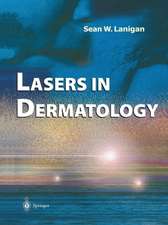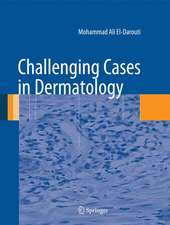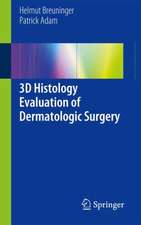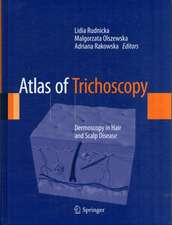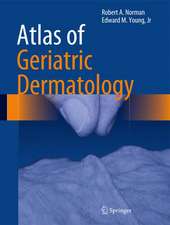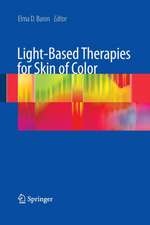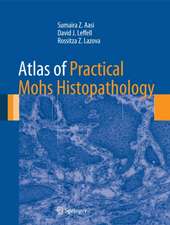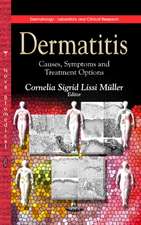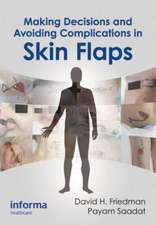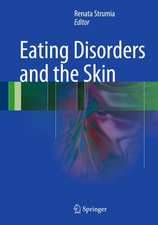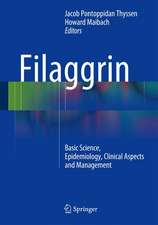Adverse Cutaneous Drug Reactions to Cardiovascular Drugs
Autor Esen Özkaya, Kurtuluş Didem Yazganoğluen Limba Engleză Paperback – 23 aug 2016
| Toate formatele și edițiile | Preț | Express |
|---|---|---|
| Paperback (1) | 1024.19 lei 6-8 săpt. | |
| SPRINGER LONDON – 23 aug 2016 | 1024.19 lei 6-8 săpt. | |
| Hardback (1) | 722.12 lei 6-8 săpt. | |
| SPRINGER LONDON – 2 dec 2014 | 722.12 lei 6-8 săpt. |
Preț: 1024.19 lei
Preț vechi: 1078.10 lei
-5% Nou
Puncte Express: 1536
Preț estimativ în valută:
195.98€ • 202.18$ • 163.55£
195.98€ • 202.18$ • 163.55£
Carte tipărită la comandă
Livrare economică 26 martie-09 aprilie
Preluare comenzi: 021 569.72.76
Specificații
ISBN-13: 9781447170341
ISBN-10: 1447170342
Pagini: 284
Ilustrații: XXI, 259 p. 92 illus. in color.
Dimensiuni: 155 x 235 x 15 mm
Greutate: 0.4 kg
Ediția:Softcover reprint of the original 1st ed. 2014
Editura: SPRINGER LONDON
Colecția Springer
Locul publicării:London, United Kingdom
ISBN-10: 1447170342
Pagini: 284
Ilustrații: XXI, 259 p. 92 illus. in color.
Dimensiuni: 155 x 235 x 15 mm
Greutate: 0.4 kg
Ediția:Softcover reprint of the original 1st ed. 2014
Editura: SPRINGER LONDON
Colecția Springer
Locul publicării:London, United Kingdom
Cuprins
Introduction (General information on different types of ACDR).- Angiotensin converting enzyme inhibitors.- Angiotensin II receptor blockers.- Alpha-2 adrenergic receptor agonists.- Alpha-adrenergic receptor blockers.- Adrenergic neuron blockers.- Class I antiarrhythmic drugs (sodium channel blockers) .- Beta adrenergic receptor blockers (class II antiarrhythmics) .- Class III antiarrhythmics.- Calcium channel blockers (class IV antiarrhythmics) .- Diuretics.- Sympathomimetics.- Vasodilatory drugs.- Lipid lowering drugs.- Platelet inhibitors.- Thrombolytics.- Anticoagulants.- Miscellaneous drugs.- Diagnostic procedure: The role of patch.
Notă biografică
Esen ÖZKAYA: Professor of Dermatology in İstanbul University, İstanbul Medical Faculty, Department of Dermatology and Venereology. EDUCATIONAL AND ACADEMIC BACKGROUND Graduated with the first degree from German High School İstanbul in 1984 and from İstanbul Medical Faculty, İstanbul University in 1990. Resident of Dermatology in İstanbul University, İstanbul Medical Faculty, Department of Dermatology and Venereology (1990-1994). Scholarship resident in Department of Dermatology, WWU (Westfälische Wilhelms Universität) Münster, Germany (1992-1993). Specialist of Dermatology (1994-1998), Associate Professor of Dermatology (1998-2004), and Professor of Dermatology (since 2004) in İstanbul University, İstanbul Medical Faculty, Department of Dermatology and Venereology. ACADEMIC POSITION University teacher in İstanbul University, İstanbul Medical Faculty, Department of Dermatology and Venereology (since 1998). Founder of the Dermatoallergy unit in the Department of Dermatology and Venereology, İstanbul Medical Faculty in 1996. POSTGRADUATE EDUCATIONAL PROJECTS Head of the organizing committee and tutor of the postgraduate training courses of dermatoallergy tests for dermatologists in 2007 (DATK 2007) and in 2009 (DATK 2009) AWARDS German Academic Exchange Service-DAAD scholarship award (1992-1993). Istanbul University Science Award (2003). SCIENTIFIC PUBLICATIONS Approximately 70 publications in peer-reviewed international journals and many articles in national journals mainly on allergic contact dermatitis, adverse cutaneous drug reactions, atopic dermatitis, and urticaria. Author of an upcoming Turkish book on allergic skin diseases and diagnostic tests.
KURTULUŞ DİDEM YAZGANOĞLU: Associate Professor of Dermatology in İstanbul University, İstanbul Medical Faculty, Department of Dermatology and Venereology. EDUCATIONAL AND ACADEMIC BACKGROUND Graduation from Izmir Özel Türk College, Science High School in 1994 and from Ege University Medical Faculty in 2000, Resident of Dermatology (2001-2005), Specialist of Dermatology (2006-2013), and Associate Professor of Dermatology (since 2013) in İstanbul University, İstanbul Medical Faculty, Department of Dermatology and Venereology. ACADEMIC POSITION University teacher in İstanbul University, İstanbul Medical Faculty, Department of Dermatology and Venereology (since 2013). POSTGRADUATE EDUCATIONAL PROJECTS Member of the organizing committee of postgraduate training courses of dermatoallergy tests for dermatologists in 2007 (DATK 2007) and 2009 (DATK 2009). MEMBERSHIPS Turkish Medical Association, Turkish Society of Dermatology. SCIENTIFIC PUBLICATIONS Approximately 25 publications in peer-reviewed international journals and many articles in national journals. Co-author of two previous Springer books, "Dermatologic Diseases of the Nose and Ears: An Illustrated Guide" and “Clinical Atlas of Skin Tumors”.
KURTULUŞ DİDEM YAZGANOĞLU: Associate Professor of Dermatology in İstanbul University, İstanbul Medical Faculty, Department of Dermatology and Venereology. EDUCATIONAL AND ACADEMIC BACKGROUND Graduation from Izmir Özel Türk College, Science High School in 1994 and from Ege University Medical Faculty in 2000, Resident of Dermatology (2001-2005), Specialist of Dermatology (2006-2013), and Associate Professor of Dermatology (since 2013) in İstanbul University, İstanbul Medical Faculty, Department of Dermatology and Venereology. ACADEMIC POSITION University teacher in İstanbul University, İstanbul Medical Faculty, Department of Dermatology and Venereology (since 2013). POSTGRADUATE EDUCATIONAL PROJECTS Member of the organizing committee of postgraduate training courses of dermatoallergy tests for dermatologists in 2007 (DATK 2007) and 2009 (DATK 2009). MEMBERSHIPS Turkish Medical Association, Turkish Society of Dermatology. SCIENTIFIC PUBLICATIONS Approximately 25 publications in peer-reviewed international journals and many articles in national journals. Co-author of two previous Springer books, "Dermatologic Diseases of the Nose and Ears: An Illustrated Guide" and “Clinical Atlas of Skin Tumors”.
Textul de pe ultima copertă
This book describes adverse cutaneous drug reactions as among the most frequent events in patients receiving drug therapy. Cardiovascular drugs are an important group as there are a greater number of indications for the use of new drugs and their prescription continues to increase. The exact incidence of cutaneous side effects from cardiovascular drugs is difficult to estimate due to sporadic reporting. Moreover, a reliable connection between a certain drug and a certain type of reaction can only rarely be made, aside from the well-known angioedema/urticaria from angiotensin-converting enzyme inhibitors, lichen planus/lichenoid reaction from beta adrenergic blockers, and photosensitivity from thiazid diuretics. These reactions can extend to rare but life-threatening conditions such as erythroderma, Stevens-Johnson syndrome, toxic epidermal necrolysis and drug hypersensitivity syndrome.
Adverse Cutaneous Drug Reactions To Cardiovascular Drugs reviews the reported types of reactions to cardiovascular drugs. Each is discussed according to drug class and the type of dermatologic reaction with special emphasize on cross-reactions and the role of patch testing in diagnosis. A total of 116 images are included featuring clinical appearance of common adverse cutaneous drug reactions and diagnostic procedures such as patch and photopatch testing with the suspected drugs. Complementary tables may allow to scan the most common cutaneous reactions and the related cardiovascular drugs along with the possible cross reactions at first glance. It will thus be of considerable importance to all dermatologists and medical professionals who manage the skin, while being an important reference resource for cardiologists in terms of identifying potential adverse reactions to the drugs they prescribe.
Adverse Cutaneous Drug Reactions To Cardiovascular Drugs reviews the reported types of reactions to cardiovascular drugs. Each is discussed according to drug class and the type of dermatologic reaction with special emphasize on cross-reactions and the role of patch testing in diagnosis. A total of 116 images are included featuring clinical appearance of common adverse cutaneous drug reactions and diagnostic procedures such as patch and photopatch testing with the suspected drugs. Complementary tables may allow to scan the most common cutaneous reactions and the related cardiovascular drugs along with the possible cross reactions at first glance. It will thus be of considerable importance to all dermatologists and medical professionals who manage the skin, while being an important reference resource for cardiologists in terms of identifying potential adverse reactions to the drugs they prescribe.
Caracteristici
Comprehensive review with color photos on skin side effects of cardiovascular drugs Includes useful tables allowing diagnosis according to drug class and the type of dermatologic reaction at a glance Special emphasis on cross-reactions and the role of patch testing in diagnosis Easy access and common use in dermatology outpatient clinics

